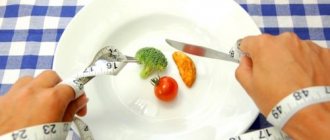What it is
Insulin is a hormone responsible for the amount of glucose entering the blood. Determines the intensity and sharpness of jumps. Necessary for the breakdown of complex carbohydrates coming from food. The process of its release is an “insulin response.” As a conductor, it “transports” glucose to the liver and muscle tissue, forming glycogen. The task of the first is to maintain normal levels, preventing them from falling to a critical point. The second is stored for an “emergency” case when the glucose supply completely stops. It is also consumed when a person experiences intense physical activity.
Products for proper nutrition
For example, chocolate, sugar, fruits break down in a short time and provoke internal resonance. They act on their own without triggering hormone production. In its absence, glucose is not transported, since the tissues do not allow it to enter their cells, and then deposition occurs in the fat layer.
The pancreas secretes it every time a person eats. The quantity and speed of production depends on the product. This is what is called the insulin index.
Attention: High AI products!
If you are striving for an ideal figure, then you should exclude carbohydrate foods and foods that are sources of starch from your diet. They have the highest insulin index. Potentially dangerous foods include melon, potatoes, pancakes, pancakes and any baked goods made from white flour, gummy candies, instant cereal, beets, grapes and bananas.
Remember that to lose weight you need to include foods rich in plant fiber in your body. It actively inhibits the absorption of sugar into the blood. Therefore, insulin is produced by the pancreas slowly and in small quantities. That is, the body is actively saturated, but at the same time continues to melt fats and does not store them in reserve.
Always find out the insulin and glycemic index of foods for proper weight loss, and then the results of your workouts and diet will not be long in coming.
Interesting: What effect does sugar have on the human body?
Write in the comments: Did you know about AI and its effect on the body?
Why is it needed?
It should be monitored by people with diabetes and pre-diabetic health conditions. They do not produce the hormone at all or the mechanism for producing the hormone is disrupted. Therefore, glucose concentrates in the blood, not nourishing the cells, but destroying them. Knowing how the internal organs will react to a specific dish, a person can calculate the dose that needs to be administered by injection.
In obese people, any snack triggers the internal production process in huge quantities, and it immediately turns into fat. Losing weight is not very easy. You have to carefully control the composition of dishes and calculate calories by gram (which does not always help).
Uncontrolled obesity
Research has shown that tissue sensitivity may decrease. This insulin resistance leads to disease. A person finds himself in a vicious circle: poor nutrition leads to failure, and this contributes to weight gain. The development of insulin resistance can also be influenced by: pregnancy, poor sleep and stress, and old age.
For those who watch their figure and lead a healthy lifestyle, experts also recommend paying attention to this. Excessive amounts of glucose cause the pancreas to work harder. Leads to metabolic disorders, blocking the production of fat-burning enzymes. A person quickly loses the feeling of fullness and constantly feels hungry.
Foods with a low or medium index require more energy to process and increase sugar levels gradually, without sudden spikes.
So, we can draw the following conclusions:
- The basis of the diet is food with a low index;
- Products with a high numerical value are also necessary to maintain human life, but in smaller quantities.
conclusions
The insulin index is a concept that is important to correctly interpret for those who intend to lose weight or improve their health. It is this value of the product that determines how food affects insulin production. And if we take this value into account, we can conclude that it is possible to gain weight even from those foods that are considered dietary. When scientists identified this indicator, it became clear that not only sweets and baked goods can cause extra pounds. After all, the pancreatic hormone is actively released after consuming cottage cheese or yogurt, which most people consider “harmless” from a dietary point of view.
Therefore, it is worth taking this indicator into account and when preparing a diet, pay attention not only to the glycemic index, but also to the insulin index. And people who have diabetes must learn the basic AI indicators in order to create the most healthy and correct menu for themselves.
Coefficient
People with first-degree diabetes use external insulin if their glucose exceeds 6 mmol. When calculating the daily dose, it is necessary to take into account the amount coming from food, plus artificial insulin. This correction factor is necessary to adjust to avoid hypoglycemia (too low levels) or hyperglycemia.
Important:
Ratio graph
- adjust the diet;
- calculate the amount of carbohydrates. It should be the same every day;
- adhere to a uniform diet;
- eat three times a day;
- calculate a new coefficient on days of heavy physical activity and holiday dinners. It is necessary to recalculate the consumption rate when the seasons change and during the period when a cold caught you by surprise.
Diabetics belonging to the second group can do without injections at all. But they also need to stick to their diet.
Principles of carbohydrate metabolism in the body
In order to well understand the significance and value of various indices in nutritionists and medicine, it is necessary to be able to associate them with the biochemical processes that take place in the body. It is known that the supply of energy necessary for life can be obtained from food containing carbohydrates (as a result of metabolism).
As soon as food enters the body, the process of breaking down complex carbohydrates begins.
During chemical transformations, saccharides with simple chemical composition are released:
- glucose (the main amount of monosaccharide);
- fructose.
These substances then enter the blood and are distributed throughout the body. As a result, you can observe how the blood sugar level increases after eating. The pancreas, as the source of insulin production, receives a signal that there is a need to release the hormone in order to reduce glucose levels to normal values.
In turn, insulin ensures access of sugar to muscles and fat cells, thereby providing them with adequate nutrition. If there is little insulin, tissues and cells will not be able to pass sugar.
Some amount of glucose and fructose is used by the body to form its energy resources. The unused portion is stored, resulting in a reserve of a substance called glycogen.
Its main task is to maintain optimal sugar levels, which will be sufficient from one meal to the next. Another function of glycogen is to maintain and restore glucose to normal levels when the body experiences physical activity.
If the pancreas produces a small amount of insulin, then type 1 diabetes develops - insulin dependent.
In the case when the substance is produced in sufficient quantities, but the cells lose their natural sensitivity to insulin, type 2 diabetes occurs, which does not require a special influx of the hormone into the body from the outside (using injections) - insulin-independent.
In this case, nutritional adjustments are necessary. Scientifically derived index tables - glycemic and insulin - come to the rescue. Their importance lies in the fact that products with suitable values help maintain indicators in normal values, reducing the threat of various complications.
Insulin index of food products in tables
It is not possible to make AI calculations at home. Therefore, scientists did this during experiments. For ease of use, the numerical values are listed in tables.
Vegetables
| AI | AI | ||
| Herbs (parsley and basil) | 5 | Olives | 15 |
| Sauerkraut | 15 | Brussels sprouts | 15 |
| Leaf salad | 10 | Stewed cauliflower | 15 |
| Fresh tomatoes | 10 | Leek | 15 |
| Onion | 10 | Red pepper | 15 |
| White cabbage | 15 | Fresh cucumbers | 15 |
| Broccoli | 10 | Eggplant | 10 |
| Beans | 20 | Fried cauliflower | 35 |
| Green pepper | 10 | Garlic | 35 |
| Dill | 15 | Carrot | 35 |
| Spinach | 15 | Eggplant caviar | 40 |
| Asparagus | 15 | Green pea | 40 |
| Radish | 15 | Fresh lentils | 20 |
| Potato chips | 61 | French fries | 95 |
| Boiled potatoes | 120 | Fried potatoes | 95 |
| Boiled beets | 64 | Boiled corn | 70 |
| Baked pumpkin | 75 | Vegetable stew | 55 |
| Fried zucchini | 75 | Boiled lentils | 85 |
| Baked beans | 120 | Beans | 120 |
| Vegetable stew | 55 | Fried potatoes | 95 |
| Corn grains | 70 |
Vegetables table
Fruits vegetables
| AI | AI | ||
| Pomegranate | 35 | Plums | 35 |
| Apricot | 35 | Red Ribes | 25 |
| Black currant | 15 | Peach | 35 |
| Mandarin | 30 | Dried apples | 30 |
| Pear | 30 | Dried apricots | 30 |
| Raspberries | 25 | Blueberry | 25 |
| Gooseberry | 25 | Grapefruit | 25 |
| Strawberry | 25 | Cherries | 25 |
| Bananas | 81 | Grape | 83 |
| Dried fruit mixture | 110 | Oranges | 60 |
| Apples | 59 | Melon | 92 |
Fruits and vegetables table
Milk products
| AI | AI | ||
| Cottage cheese | 45 | Cheese | 45 |
| Milk 2.5% | 90 | Yogurt | 115 |
| Ice cream | 89 | Kefir | 98 |
| Lactose | 50 | Sour cream | 98 |
Dairy products table
Confectionery
| AI | AI | ||
| Cake | 82 | Cracker | 87 |
| Cookie | 92 | Chocolate bar "Mars" | 112 |
| Caramel | 160 | Cake | 83 |
| Cake | 83 | Jelly sweets | 120 |
Pastry table
Bakery products
| AI | AI | ||
| Donuts | 74 | Croissants | 79 |
| Black bread | 96 | White bread | 100 |
| Crackers | 86 | Bran bread | 56 |
Bakery products table
Cereals and pasta
| AI | AI | ||
| Oatmeal | 40 | Durum pasta | 40 |
| Muesli | 46 | White rice | 79 |
| Brown rice | 62 | Cornflakes | 75 |
| Cereals | 75 |
Table of cereals and pasta
Meat
| AI | AI | ||
| Beef tenderloin | 49 | Chicken fillet meat | 20 |
Meat table
Indicators below 50 units are a low level of influence on the functioning of the pancreas. If a product in the table has a number greater than 50, it means that it provokes a sharp insulin response.
Just do not confuse the tables of insulin and glycemic values. The second shows changes in the amount of sugar in the blood after eating. AI and GI can be very different. For example, the glycemic value of apples is much lower than the insulin content. Therefore, the concentration of sugars will not increase, but insulin will be released with redoubled force. In this case, the generation of lipase is blocked and fat accumulates under the skin layer.
Practical application of GI and AI
The general recommendation for everyone except insulin-dependent diabetics is that when comparing two parameters, you need to focus more on GI, and then adapt your diet to AI and other parameters. But you shouldn’t neglect AI either - increased insulin production depletes the insulin gland, giving the command to accumulate fat rather than using the reserves of what is already available.
How to use tables
Low numbers for many vegetables, cheese, eggs, durum pasta, and oatmeal. The largest are for baked goods and sweets. The highest value of a piece of white bread was taken as the standard for the index. It is equal to 100 units.
Using the data from the tables, you can create the correct menu. It is important to remember some features:
- Proteins (meat, fish and milk) are recommended to be combined with vegetables. You cannot add cereals, starch (bread, pasta), sweets;
- Breakfast should consist of protein;
- In the evening, prepare food that has complex ingredients;
- An excellent combination is obtained from vegetables, protein and fats;
- Cereals can be included in the diet in tandem with fats;
- Dairy products contain many elements that are beneficial to health. But they put a lot of stress on the pancreas. It is better to eat such food in the first half of the day and exclude it from dishes intended for dinner;
- You should not combine proteins and carbohydrates (cottage cheese + honey);
- You can have complex carbohydrates plus unsaturated fats (fish + nuts);
- Heat treatment is not advisable. It is usually excluded whenever possible.
Breakfast can consist of carbohydrates, a combined lunch and a protein dinner. Looking at the tables, you can see that one of the best combination options is fish with vegetables.
Diet taking into account the insulin index
The main rule is to include foods with increased AI in your diet in the first half of the day. In this case, fat and calories will be burned at night. While a person sleeps, his weight melts and his cells are cleansed.
Products for diet
- The diet includes three meals a day and no snacks.
- The interval between meals should be at least five hours.
- Dinner three hours before bedtime.
- Watch out for fats - no more than 20 g at each meal.
- You can make porridge more healthy if you do not add milk and butter to it.
- It would seem that such harmless food as buckwheat and stewed vegetables can cause damage to your figure and health if you add beef to them. It is better to eat porridge separately from meat.
- There is no need to mix foods with high and low AI scores. Otherwise, you will get a big insulin surge.
- It is advisable to use olive oil, not vegetable oil.
A complete diet should consist of combined dishes. The menu should be drawn up based on the characteristics of a person’s health.
The release is also stimulated by fatty and protein foods, if consumed in large quantities. For example, milk or fatty fish do not contain many carbohydrates, but they provoke the release of the hormone. The figure for dairy products (excluding cheese), despite the fact that they are low in calories, is quite high. So, for cottage cheese it is 120 units. It becomes clear why many diets based on dishes containing milk in one form or another do not work. By eating them for dinner, a person provokes a surge in insulin and inhibits fat burning.
You should eat sweet fruits with caution; it is better to eat carrots. Avoid fried foods. It is better to avoid consuming sugar. In baking, it can be replaced with fruit puree, such as applesauce.
Those with a sweet tooth can diversify their diet with baked apples and fruit salads with yogurt as a dressing.
Food products on store shelves labeled “Dietary” are categorically not suitable for a diet. After all, in their composition fats are replaced with carbohydrates.
Glycemic index
The glycemic index (GI) characterizes the degree of absorption of complex carbohydrates from food and the subsequent level of blood saturation with glucose. The GI value depends on the ability of complex carbohydrates to be broken down under the influence of digestive enzymes and on a number of “external” factors associated with cultivation, production technologies, storage conditions and culinary processing of food.
The GI value was determined experimentally - after taking a certain product, for 2 hours, every 15 minutes, a blood sugar test was carried out. Naturally, for such a comparison of the behavior of dietary carbohydrates and compiling a table, we took ordinary glucose as the starting point - absorption of 100 g = 100% or 1 g of glucose equals 1 conventional GI unit.
Sample menu
All dishes are steamed. You can eat 1-2 slices of bread per day. It is better to choose grain, rye.
The first day
- Breakfast: broccoli omelette; fruit; coffee drink without sugar.
- Lunch: soup with cereal; chicken meat; buckwheat; herbal drink.
- Dinner: fish with vegetables and water.
Dinner fish with vegetables
Second day
Dinner with rice and beef
- Breakfast: oatmeal; a handful of berries, water.
- Lunch: vegetable salad with olive oil; soup with cereals; grapefruit, herbal drink.
- Dinner: a small piece of beef tenderloin, a side dish of rice, water.
The result will be noticeable within a month: your health will improve and the extra pounds will begin to melt away.











